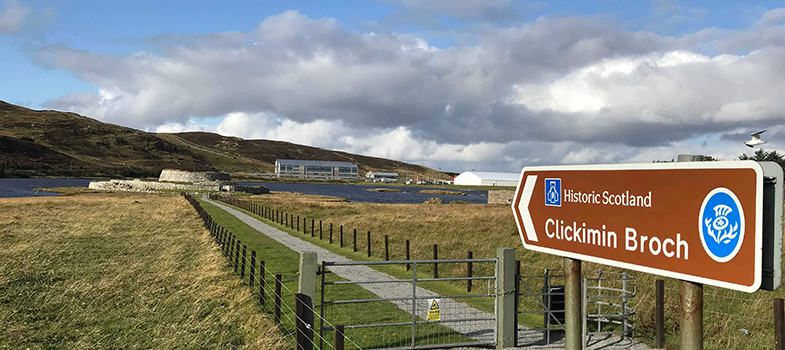17.2 Some widespread features of Scots grammar
A key feature of this unit is to show you that the speakers of a language make its grammar – not the grammar books and the people who write them. Remember that grammar is flexible and fluid, it changes with the way in which speakers use their language.
That is why you will come across questions where we ask about your opinion – and on how you as the speaker use the language, or consider it used well.
In addition, you will be able to listen to and record yourself speaking many examples containing different grammatical features of Scots, which will help you get used to how Scots grammar works and how Scots words are used in their grammatical context.
I. Negatives
a) To make a negative, add to the relevant verb:
-nae (e.g. West Central, East Central South) or
-na (e.g. North East, Shetland) where English speakers would use -n’t:
Examples:
Transcript
Listen
It wisnae bonny
Model
It wisnae bonny
Transcript
Listen
They canna get oot.
Model
They canna get oot.
b) Nivver is used in the sense of not to refer to one particular occasion. There is no emphasis intended.
Examples:
Transcript
Listen
A nivver bocht it.
Model
A nivver bocht it.
Transcript
Listen
I bade in aa day but the postman nivver cam.
Model
I bade in aa day but the postman nivver cam.
c) As in many regional varieties of English, and as was common in earlier times, double or triple negatives are often used to emphasise negativity rather than cancelling each other out.
Examples:
Transcript
Listen
A nivver had nae denner.
Model
A nivver had nae denner.
Transcript
Listen
A nivver said naething tae naebody.
Model
A nivver said naething tae naebody.
II. Past tenses
Where English uses -ed to form a part tense or past participle, Scots often uses -it. Work with the examples below and make sure to read the transcript, which also contains important grammatical information.
Examples:
Transcript
Listen
A lowpit the dyke. (past tense)
Model
A lowpit the dyke. (past tense)
Transcript
Listen
He haes chappit the tatties. (past participle)
Model
He haes chappit the tatties. (past participle)
Transcript
Listen
The cairtie wis coupit. . (past participle)
Model
The cairtie wis coupit. . (past participle)
*Note that for these verbs, the past tense and the past participle have the same form. There are other verbs, like blaw, where they change: blaw, blew (past tense), blawn (past participle). Over hundreds of years, verbs have been changing to make the grammar more regular. So, in Scots it is also possible to use blawed for the past tense and past participle.
Compare English give, gave, given with Scots gie, gied, gied or gien. In this word, Scots would appear to have gone further along the road to simplification but this is not always the case. For example, you will hear the past tenses dove (dived) and jamp (jumped) in some parts of Scotland.
As well as making more verbs end in -ed or -it, another way of simplifying verbs is to make the past tense and the past participle the same. A seen and A done are examples of simplification in progress. See, saw, seen may eventually become see seen seen if enough people accept and actively use it.
Language simplification – innovation or bad grammar? 
What do you think – should we consider these changes in relation to the simplification of grammatical forms as innovation or bad grammar? Why? Remember, some people deem more complex grammar a sign of ‘good language’, whereas others think a language is good when its grammar is relatively simple and thus easier to use by its speakers and people learning it as a foreign language.
III. Narrative Present Tense
This grammatical feature is often used to bring vividness into a story. Note that the endings are not the same as in the ordinary present tense. The narrative present tense has an -s ending for every verb in the sentence/text, whereas in the normal present tense this would only apply to the third person singular.
Example:
Transcript
Listen
We gets aff the train and she says nothing.
Model
We gets aff the train and she says nothing.
Transcript
Listen
I keeps quiet an aa.
Model
I keeps quiet an aa.
*(Chaucer used to do this in Middle English but this has disappeared from standard English today).
IV. Comparisons
Where English uses than to make comparisons, Scots is more likely to use nor.
Example:
Transcript
Listen
This ane’s better nor thon.
Model
This ane’s better nor thon.
Language development – innovation or bad grammar? 
Strictly speaking, nor is a conjunction, like than. So just as an English grammar book would tell you to say “He is bigger than I (am)”, the more historically justifiable Scots form would suggest He is bigger nor I. Is that what people really say? Do you feel there is anything wrong with He is bigger nor me? Remember it is people who make grammar rules, not books.
Activity 5
You are now going to test your understanding of the four grammatical features of Scots: negatives, past tenses, narrative present tense and comparisons. To do so, you will work with extracts from two texts you have already come across in this course. Highlight any instances of any of the four grammatical features in the two extracts.
Part 1
Discussion
*This extract contains examples of negatives and past tenses – note also a past tense with the ending –t in wandert, where the ‘i’ has been left out of the past tense ending as it would not be pronounced. There is also one example of a comparison with nor.
Part 2
Discussion
*This extract includes examples of negatives and narrative present tense.
17.1 Why grammar?

